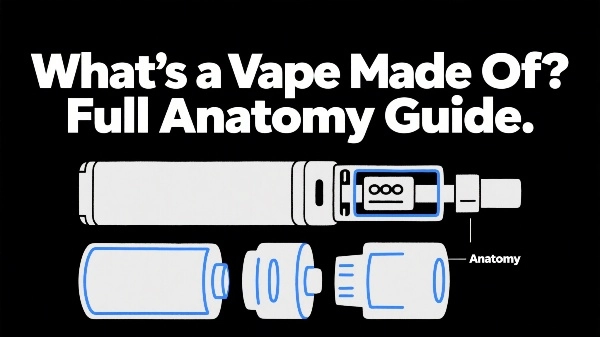If you’re new to vaping, it’s important to understand how vape devices are built. This helps you avoid any safety issues and keeps your device in great condition. A vape is made up of four main parts: the Power Core (Battery), Atomization Heart (Atomizer), E-liquid Storage (E-liquid Tank), and Interaction Port (Mouthpiece). These parts work together like precision gears.
The battery is the power source, and how long the battery lasts and how safe it is to use depend on the battery. At the moment, most e-cigarettes use lithium batteries that are built-in or removable. It is recommended that you choose models that have vape battery safety protection. The heating wire and atomizer coil are both important for how well the vapor is made. If you want a delicate taste, ceramic coils are better. If you want a strong vapor experience, wound coils are better. The way the e-liquid tank is sealed and how much it can hold affect how likely it is to leak and how easy it is to use. Models with a window in the lid make it easy to see how much e-liquid is left. The material (such as food-grade resin or metal) and the shape of the mouthpiece affect how comfortable it is to breathe in.
Once you know what these parts are, you can choose based on what you need: if you want something that you can carry around easily, go for integrated pod systems; if you’re an enthusiast who likes to do their repairs and modifications, go for modular devices. If you take care of your vape, such as cleaning the atomizer coil regularly and not overcharging, you can make it last over 30% longer. From understanding how the body is built to looking after it, this anatomy guide is the key to scientific usage.
Breakdown of Core Vape Components: A Detailed Look Inside
Battery: The Powerhouse of a vape
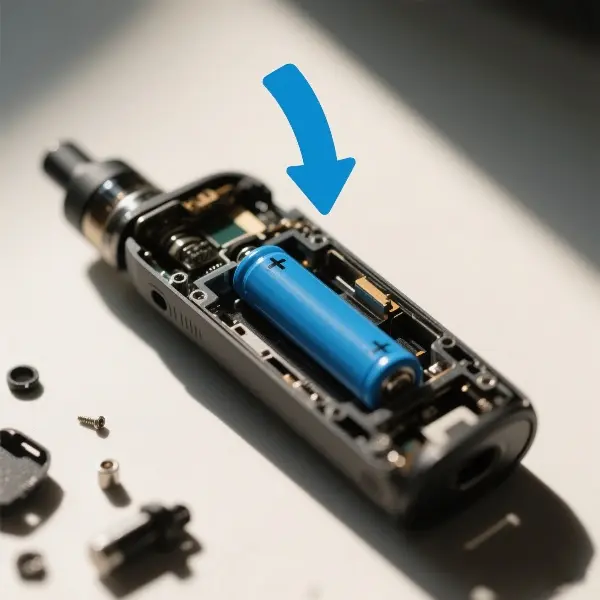
The battery is the most important part of a vape, and it directly affects how the user experiences it and how safe it is. Here is a detailed breakdown:
Main Job: The Vapor Experience Engine
The battery is the most important part of the vape because it provides the current that heats the atomizer’s heating wire, turning e-liquid into vapor. The stability of its output affects the temperature, volume, and flavour of the vapour. High-power batteries are better for users who want large clouds, while low-power ones are better for users who want to control the temperature to preserve the original taste of the e-liquid. The battery must provide consistent power. This helps to make sure that the atomization is even and that the coil does not burn. This is important for making sure that the performance is smooth and reliable.
Material Safety: Watch out for hidden risks
Lithium-ion batteries (Li-ion) are used in 90% of vapes because they are small and powerful, but they can be dangerous. If they get too hot, are overcharged, or are made by poor quality companies, they can cause short circuits, swelling, or even explosions. When buying a vape battery, always look for a safety certificate (e.g., CE, UL) and avoid batteries that don’t have a brand name. When you use it, don’t vape while it’s charging, drop the device, or leave it plugged in after it’s fully charged. These habits get rid of any hidden safety problems.
Lifespan Decay: Here’s how to make your battery last longer
The battery’s charge cycles are how we measure its battery life (one full charge and discharge cycle is equal to one cycle). The battery’s capacity usually drops by more than 20% after 300 to 500 charging cycles. This can make the battery run for less time and charge more slowly. Here are three tips to make your vape battery last longer:
- Clean the electrode contacts: Wipe with a cotton swab to remove oxidation, which can stop electricity from conducting.
- Avoid deep discharge: Make sure you charge the battery when it goes below 20% to stop the phone from breaking because the battery is too empty.
- Store at the best temperature. Make sure it doesn’t get too hot or too cold. To store it for a long time, keep it at about half its usual charge. This will keep the battery healthy.
Charger Selection: Only use adapters that the manufacturer recommends.
Using a random charger is risky! Using the wrong voltage and current (e.g., 5V/2A fast charging for a 3.7V battery) can make the battery age faster and may trigger overcharge protection. Always use a charger that is recommended by the manufacturer. This will protect you against problems caused by too much voltage or current. Never charge it overnight or when you are not there to look after it – these small details are important for safety.
Everything about the battery, from how it’s made to how it’s looked after, affects how you vape and how safe it is. Master these tips and you’ll enjoy longer battery life, smoother vapor, and you won’t have to worry about any risks to your device.
E-liquid Tank: The part of the vapor that controls its flavour
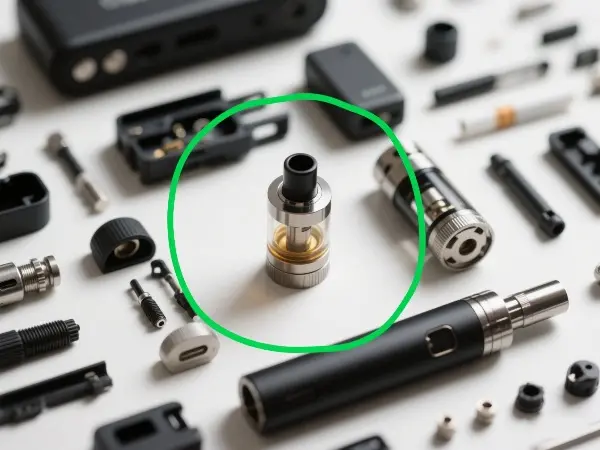
Core Structure: Introducing the Micro-Factory of Vapor Creation
The e-liquid tank is the most important part of a vape because it holds the liquid and makes it vaporize. It has a precise structure that is similar to a steam laboratory:
- Liquid Reservoir: It is usually made of heat-resistant glass or plastic that is safe to use with food. People like glass because it is both clear and strong, and it is also safe. Plastic is good for the outside because it is lightweight but strong.
- Coil: The hidden heat engine inside the tank consists of heating wires (e.g., nichrome, kanthal) wrapped around ceramic or cotton wicks. It changes electrical energy into heat, which affects how fine the vapour is and how well the flavour of the e-liquid is reproduced.
- Mouthpiece: The tactile gateway for human-device interaction has a curved shape that is comfortable for the lips. The materials range from skin-friendly resin to metal, and some premium models have anti-condensation technology to stop coughing when you breathe in.
- Airflow System: The pipe is made up of holes at the bottom and vapor paths, and the temperature of the vapor is regulated by adjusting the air that is drawn in. If there is a lot of airflow, the vapor is cool and dense, while if there is not much airflow, the vapor is rich and full-bodied.
Type Selection: Find the right type of vapor for you
Tanks are divided into three types based on how they are used and how much the user knows:
- Replaceable Coil Tank: It’s perfect for beginners and people who travel to work. It has standard coils that can be replaced in 30 seconds when they run out. It can hold between 2 and 5 millilitres, so you can top it up easily and take it with you.
- Rebuildable Battery Atomizer (RBA): This is a customization station for more experienced users. It allows you to wind the heating wires yourself and trim the cotton wicks. Every detail, from the coil diameter to the airflow angle, can be adjusted to perfection. This makes it ideal for both professional vapers and those who want to produce their vape juice at home.
- Disposable Pod: You can use this for a short time, and it comes with nicotine salt e-liquid already in it. You can use it and then throw it away. You don’t need to do anything to keep it working. It’s great for parties and as a backup.
Selection and Maintenance: The quality of your experience depends on the details
- Capacity Choice: If you use a lot of vape juice, you can choose a “giant” tank over 5ml to reduce how often you have to refill it. If you are more concerned about portability, you should choose a mini-tank under 2ml, which is compatible with vape pod systems.
- Material Consideration: If you want to use it for a long time with e-liquids that are high in vegetable glycerin, we recommend using glass reservoirs. This is because plastic can corrode and give off a bad smell. If the liquid is very acidic, like nicotine salts, check that it doesn’t cause rust.
- Daily Maintenance: Wipe out any bits on the inside with a cotton swab before you put more e-liquid in. Rinse the mouthpiece and air holes regularly with warm water (don’t put the electrical components in the water). Dry them thoroughly, and put them back together. This is important to stop coil burning and leakage caused by residue buildup.
Every part of how the e-liquid tank is designed, from how it is stored to how the liquid is vaporized, affects the user’s inhalation experience. If you like the idea of being able to use and dispose of them quickly, or if you like the idea of building your own, then choosing the right tank and looking after it will make sure that every time you use it, the flavour of the e-liquid is exactly what you want, and that it doesn’t leak or burn.
Coil: The Soul of Vapor Taste
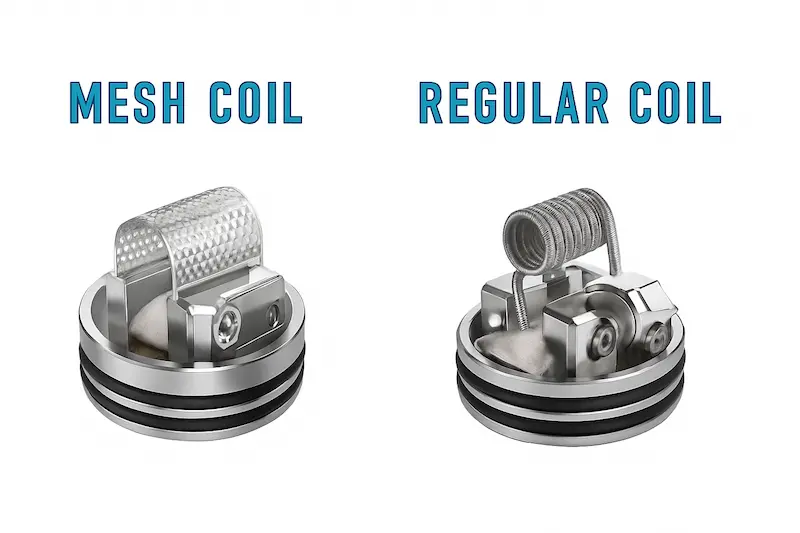
The coil is the part that makes the vapor. It also controls the flavour of the e-liquid. The Mesh Coil is a new type of vape that has become very popular. Its special design makes it much better than other vapes. It is more than just a heating element. It is an exact art that balances the size of the cloud, the flavour, and how long it lasts.
Mesh Coil: From Linear to Planar Heating Innovation
Traditional coils (e.g., Clapton coils, tight-wound coils) act like point light sources, while mesh coils form a 3D heating network. They are made from a special type of metal mesh (similar to nichrome and stainless steel) that makes them 3 to 5 times bigger. This design has three main benefits:
- Produce 30% more vapour. The e-liquid is heated all over at once, which makes it into a mist that fills your mouth when you breathe in. This is great for people who love to make big clouds of mist.
- Purer Flavor Reproduction: It stops the taste of burnt electricity from building up in the coil. The mesh structure gently heats every drop of e-liquid, bringing back the fresh sweetness of fruits, the smooth richness of tobacco, and even the icy layers of cold brew flavors.
- 40% Longer Lifespan: The heat is spread evenly, so the filament doesn’t have a chance to melt at one point. It works well even when used a lot, so you don’t need to change the coils every three days.
Coil Replacement: Essential Maintenance for Peak Experience
Whether you’re a beginner or a pro vaper, it’s important to change the coil regularly (every 2–4 weeks, depending on how often you vape). This keeps the coil working at its best. To avoid dry burns and burnt coils, follow these steps:
- Power Off and Disassemble: Turn off the device, unscrew the tank, and tilt it to stop e-liquid from spilling.
- Remove the Old Coil: Carefully pull out the coil by its base. Use a tissue to protect your hand from the hot e-liquid that may be left on it.
- Prime the New Coil: Put 3–4 drops of matching e-liquid on the wick (don’t let any drip directly onto the mesh) to fully soak it. This will stop it from burning during the first use.
- Install and Rest: Screw in the coil, refill the e-liquid, and let it sit for 5 minutes. Before you use it, press and hold the fire button for three seconds without inhaling. This will heat the coil evenly.
Wicking Materials (Delivery System)
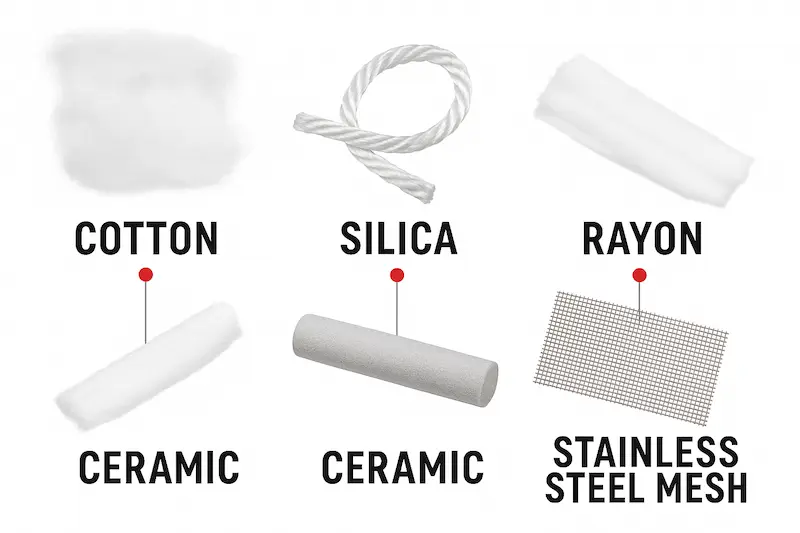
The materials that help to stop the vape from getting wet (the delivery system) are very important for how well the vape works and how the user experiences it. They soak up e-liquid from the tank or pod and send it to the heating element (coil) to make vapour.
Common Types of Wicking Materials
- Cotton: The most common wicking material is great at absorbing and transferring liquids, which helps to keep the flavour pure.
- Silica: It can resist high temperatures and is long-lasting, but it is not as effective at moving e-liquid around as cotton.
- Ceramic: It is stable and heat-resistant, and has become more popular in vapes recently.
- Rayon: Made from wood pulp, it soaks up liquids easily and can resist high temperatures, keeping the flavour of the tea intact.
- Stainless Steel Mesh: This is mostly used in Genesis-style atomizers. Before you use it, you need to make sure it is properly oxidised. This will stop it from short-circuiting.
Factors to Consider When Choosing Wicking Materials
- Wicking Efficiency: Materials should quickly absorb and transport e-liquid to avoid dry burns.
- Heat Resistance: It can handle high temperatures from the heating element, making it safe and long-lasting.
- Flavor Purity: It should not change the flavour of the e-liquid, so you get a clean taste.
- Durability: Using good-quality materials makes the coil last longer, and you won’t need to replace it as often.
Selection Guide: Match Your Vaping Style
- Beginner-Friendly: Choose prefabricated mesh coils labelled “easy install,” with resistances above 1.2Ω (e.g., 1.2Ω, 1.5Ω) to lower power requirements and work with pod systems.
- Advanced Users: DIY mesh sheets (cuttable mesh) are perfect for players who want to get the heating right for their own needs. You can adjust the power (we recommend 50–80W) using the mods to control the temperature, which will give you a cool inhale and a warm exhale.
- Long-Lasting Performance: Look for dual mesh designs, which make the heating area twice as big. This makes the battery last longer and keeps the output steady, which is perfect for using it outdoors for a long time.
From traditional coils to the mesh revolution, the way coils have changed shows how vaping has gotten better. Knowing how to use them properly – keeping the wicks wet to avoid dry burns, matching the power to avoid overloading, and replacing them regularly to prevent build-up – makes sure every puff of smoke has the e-liquid’s flavour, without any nasty odours or malfunctions. The most important thing for vaping is the coil.
E-liquid: The Flavor Codebook of Vapor
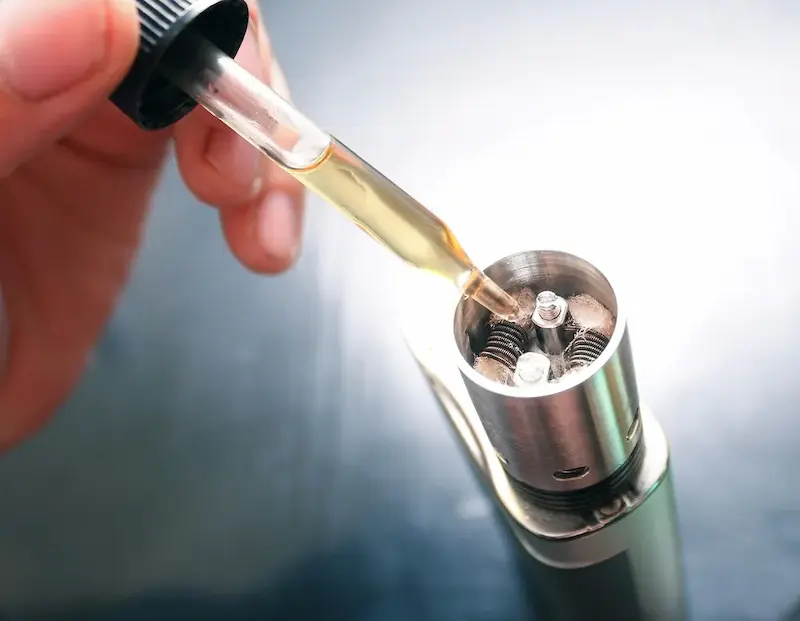
The appeal of e-liquid comes from the exact mix of four main ingredients. These are the ones that carry the vapor and the ones that shape your inhalation experience. It’s important to understand the different liquid codes so you can choose the one that best matches your taste and needs.
The Dynamic Duo: PG & VG for Taste Balance
- Propylene Glycol (PG): As soon as you feel the throat hit, the food-grade solvent quickly dissolves the nicotine and flavours, giving you a smooth, satisfying sensation that is similar to traditional cigarettes. It is perfect for vape pod systems because it is thin and liquid. This helps new users get used to vaping easily.
- Vegetable Glycerin (VG): Made from natural plant oils, this cloud creator gives vapor a dense, smooth texture thanks to its high viscosity and slight sweetness, perfect for the explosive cloud experience loved by sub-ohm vapers. Note: Pure VG e-liquid may clog coils; mix with at least 30% PG (the best PG/VG mixes are between 50:50 and 70:30).
Nicotine: Balancing Addiction Relief and Comfort
The only addictive ingredient in e-liquid is nicotine, and the strength of this is usually written in mg/ml (common levels: 0mg, 3mg, 6mg, 12mg):
- 0mg (Nicotine-Free): It is great for vapers who love flavour, or as a way to switch from smoking.
- 3–6mg (Low Strength): Smokers who are switching to vapes find this easier because it reduces their cravings without causing any irritation to their throats. Nicotine salts are highly recommended here because they are gentle on low-power devices.
- 12 mg+ (High Strength): Great for mouth-to-lung (MTL) pod systems, providing a quick nicotine fix. But be careful not to eat too much, as this can make you feel dizzy or sick.
Flavorings: Safety in Every Drop
The flavour of e-liquid comes from food-grade flavourings. These range from the richness of classic tobacco to the freshness of fruit slush and the creaminess of milk tea cake. Every flavour has to pass strict safety tests. Look for products that are TPD-certified and REACH-compliant to avoid risky ingredients like diacetyl, making sure each puff is safe and enjoyable.
Selection Guide: Tailor Your Perfect Blend
- Beginners: Choose a 50PG/50VG e-liquid with 3mg nicotine salts that is balanced for throat hit and coil compatibility.
- Cloud Chasers: Choose high-VG (70VG/30PG) blends for thick vapor, with low nicotine (0–6mg) to avoid flavour fatigue.
- Temperature Control Devices: Use PG-only e-liquids (the kind that only use one flavour) to get the right temperature for vaporisation and keep the flavour of the liquid pure.
The best e-liquids are made by mixing different liquids in the right amounts. You can also choose from different nicotine strengths, flavours, and safety certifications. Every smart choice ensures that vapor releases the most suitable taste on your tongue. After all, the best flavour formula is the one that feels specially made for you.
Drip Tip: The Inhalation Experience Tuner
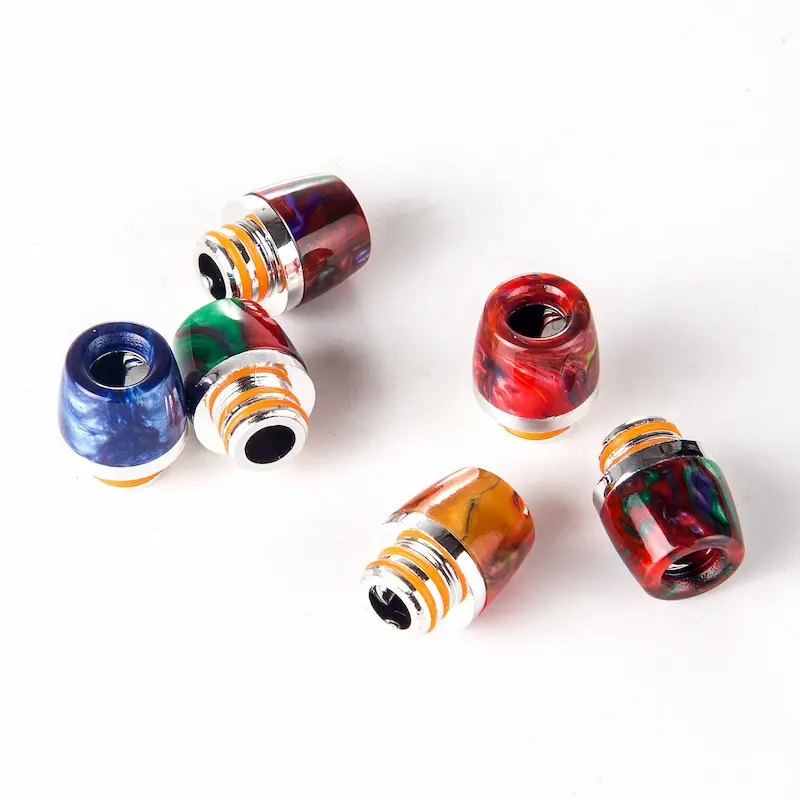
The drip tip is the final part of the vape that the user touches. It is more than just a way to control the vapor; it is also important for how comfortable it is to inhale and what the flavour is like. Every detail, from the inside diameter to the material, changes how you vape. It combines being useful and looking good, and an invisible part makes it better for the person using it.
Three Core Functions: Defining Your Inhalation Ritual
- Airflow Control Valve: The size of the hole in the drip tip affects how much air comes out and how hard it is to suck:
- 510 size (8.5mm narrow bore): It acts like a delicate filter, keeping the vapour fine, which is great for people who use mouth-to-lung (MTL) and are switching from cigarettes, as it hits a gentle throat similar to traditional smoking.
- 810 size (12.5mm wide bore): It works as a cloud accelerator, delivering a strong vapor impact during direct-to-lung (DTL) inhalation to satisfy enthusiasts who like to chase clouds.
- Temperature Regulating Filter: The material and length of the tips work like thermometers. Resin or Delrin plastic tips cool high-temperature vapour to a comfortable level, and are very heat resistant, so they won’t scald you. Metal tips (e.g., stainless steel) are durable and easy to clean, and they can conduct atomizer heat, which is good if you prefer warm vapour. Glass tips keep the flavour pure without reacting with the liquid, so they keep the taste the same as when you first made it.
- Personalization Element: From smooth to geometric designs, and from matt to bright resin finishes, drip tips are becoming a fashion accessory for vapes. You can easily switch between designs, making each one unique.
Material Choice: Balancing Comfort and Performance
- Resin: The drip tips are colourful, feel nice to the touch, and are resistant to high temperatures, making them perfect for users who like how they look and how comfortable they are, as they don’t get hot during long vaping sessions.
- Stainless Steel: It is strong and will not break if you drop it. It is also easy to clean. It has a metallic finish that looks very nice. However, it conducts heat very well, so you need to be careful not to get too hot when you use it. The heat from the atomizer can transfer through the metal, which might make it uncomfortable for users who are sensitive to heat.
- Delrin Plastic: The lightweight option, weighing just a third of metal tips, with better heat resistance than resin and resistance to chemical corrosion – perfect for all e-liquid types, especially the portability needs of pod systems.
- Glass: If you like things to have a lot of flavour, this is perfect for you. The smooth surface of this product doesn’t leave any unwanted marks, and it can also be used at high temperatures without changing its shape. Paired with a clear tank, it creates a fully see-through vapor look, but it requires careful handling – it’s best for use on a desktop.
Selection Guide: Three Steps to Your Perfect Drip Tip
- Choose by Inhalation Style:
- Cigarette transition (MTL): Use 510-bore tips made of resin or Delrin. These reduce suction resistance and enhance nicotine absorption.
- Cloud chasing (DTL): Attach 810-wide bore stainless steel/glass tips to create vapour impact.
- Match Material to Scenario:
- Outdoor use: This strong and lightweight Delrin/resin is easy to carry.
- Home use: It has a stylish design with glass and metal, and it can be personalised with engravings.
- Temperature control devices: Make sure you use heat-resistant materials so that the taste isn’t affected by the heat.
- Focus on Detail for Excellence:
- Anti-condensation design: Choose tips with curved inner walls or drainage grooves to stop coughing caused by liquid collecting in the tubes.
- Compatibility check: Make sure the 510/810 universal threading matches your device to stop it from becoming loose or leaking.
- Ergonomic angle: The 45° tilted design reduces jaw fatigue compared to flat tips, making it ideal for long-term use.
The drip tip is where the magic happens. Small changes can transform the entire experience. For example, the delicate layers from a narrow bore, the cloud impact from a wide bore, the coolness of insulated materials, and the warmth of metal, all reshape the memory of every puff. It’s more than just an accessory; it’s a way for vapers to connect with their device. Choosing the right drip tip makes inhaling a sensory delight, so every breath has a different flavour.
Mod Temperature Control Mode: The Smart Steward of Vapor Temperature
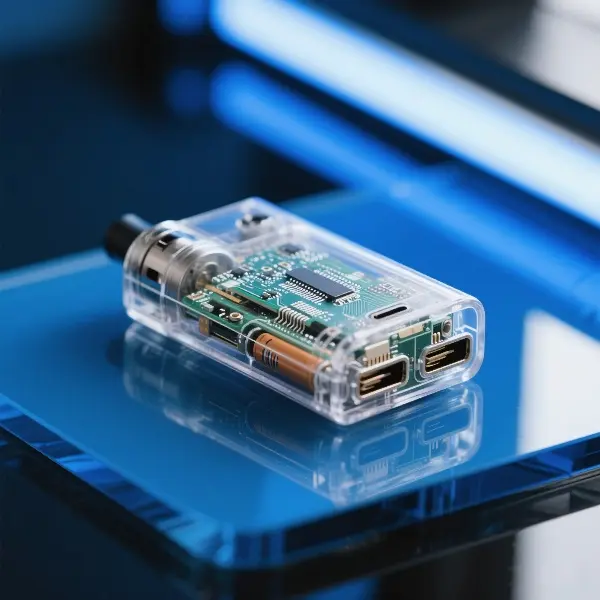
The Mod’s Temperature Control (TC) mode is the brain of a vape. It is advanced technology that balances safety, flavour, and battery life. It’s not just a simple numerical setting; it’s a flavour magician, making sure every puff is perfectly balanced. For users who want precision, TC mode is the key to avoiding dry burns and unlocking the full flavour.
Core Functions: From Blind Heating to Precision Temperature Lock
TC mode constantly checks the coil temperature (using materials like nickel, titanium, or stainless steel that are sensitive to temperature), and adjusts the power output to exactly match the temperature that the user has set (usually between 100 and 300°C). This means:
- Dry Burn Protection Shield: It automatically reduces power when the wick is undersaturated, which prevents coil fusing from high heat and cuts dry burn risks by over 70% (coil dry burn prevention).
- Flavor Preservation Box: Different e-liquids have the best vaporization temperature (e.g., 180–220°C for fruit to lock in freshness, 230–260°C for tobacco to enhance richness). TC mode stops things from overheating or caramelising, so you get all the sweetness of peach or the bitterness of coffee.
- Coil Lifespan Extender: Keeping the temperature the same stops the coil from getting worn out by expansion and contraction. Paired with nickel 200 (Ni200) coils, the lifespan can be extended from 30 to 50+ hours.
Technical Analysis: The Personality Profiles of Three TC Modes
- Nickel Temperature Control (Ni-TC): The most classic TC solution, with an ultra-fast response (0.1-second level), is ideal for beginners. Recommended temperature: 160–240°C, works with most standard e-liquids.
- Titanium Temperature Control (Ti-TC): This kind can resist heat up to 300°C and produces a softer vapour. It is perfect for high-VG e-liquids (70 %+ VG) when you want to make a lot of vapour that feels like a cloud, and it doesn’t scald your mouth.
- Stainless Steel Temperature Control (SS-TC): This is the most useful as it doesn’t need special coils and can be used by people doing DIY with normal A1 wire. The temperature ceiling is 280°C, which balances flavour and cost-effectiveness.
Scenario Applications: Temperature Codes for Different Users
- New Users Transitioning from Cigarettes: Lock in 200°C+ with a mouth-to-lung (MTL) mouthpiece that mimics the 350°C combustion temperature of traditional cigarettes to maintain the throat hit without harsh heat, speeding up the transition to vaping.
- Flavor Connoisseurs: Slow-cook fruit e-liquids at 220°C to capture the citrus top notes and berry aftertaste. Paired with a glass mouthpiece, each puff unfolds like a flavour portrait on the tongue.
- Cloud-Chasing Enthusiasts: Activate Titanium TC at 300°C with direct-to-lung (DTL) inhalation. High VG e-liquids vaporise instantly at extreme temperatures, creating a cloud waterfall through an 810 wide mouthpiece – intense visuals without scalding your throat.
TC Maintenance: Keeping the Smart Steward Responsive
- Regular Calibration: Perform coil resistance calibration via the Mod menu every 50 cycles to ensure temperature accuracy (error < ±5°C).
- Material Matching: Use coils made of the material specified for your TC mode (e.g., no stainless steel wire in Ni-TC) to avoid overloading performance due to misjudgment.
- Contact Cleaning: Wipe mod-atomiser connections with alcohol swabs weekly to prevent oxidation from interfering with resistance detection – a common overlooked cause of TC failure.
The magic of TC mode lies in taking vaping from mindless heating to personalised temperature customisation. Whether it’s a new user’s need for anti-dry burn safety or a veteran’s quest for flavour depth, fine-tuning by just a few degrees can make all the difference. Next time you vape, try lowering the temperature by 10°C – you might discover a hidden creamy undertone in your strawberry e-liquid. After all, true vape aesthetics lie in the precision of every degree.
Housing and Design: The Second Skin of a Vape
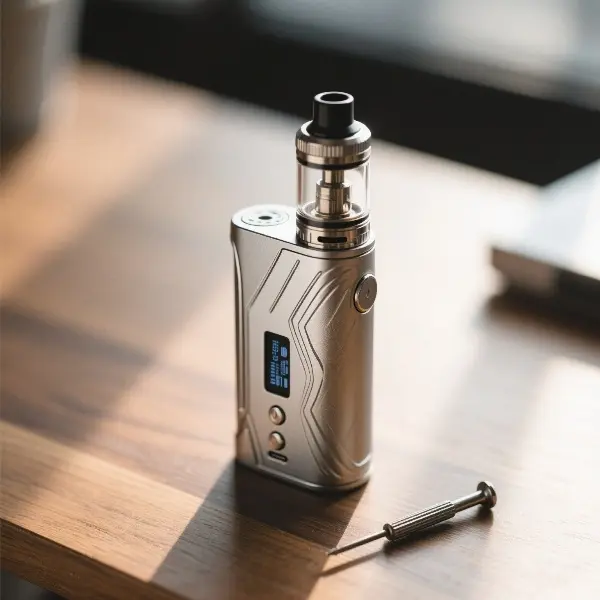
A vape’s housing is much more than a protective shell – it is an extension of the user’s personality and a tactile language for grip comfort. Every detail, from the choice of materials to the contours, tells the story of the device: it’s a palm-sized fashion accessory and an invisible key to ergonomic satisfaction.
Material Aesthetics: From Armor to Style Statement
- Metal Alloys: The cool, austere texture of stainless steel, the light toughness of aluminium, and the precision casting of zinc alloy form the hardcore camp of vape housings. Like portable metal sculptures, they offer drop resistance, ideal for outdoor users. Anodised finishes offer a wide range of colour options, from matte gunmetal to gradient electroplating, satisfying both industrial and trendy aesthetics.
- Carbon Fiber: This lightweight, aerospace-grade material creates futuristic armour with a density 1/4 that of metal but 10 times the strength. Its unique twill texture with a matte finish exudes premium tech appeal at first touch – perfect for business users seeking ‘weightless’ portability. It slips effortlessly into a shirt pocket, yet its distinctive texture makes it a conversation starter when taken out.
- Plastic & Resin: Lightweight champions win with vibrant colours and flexible shapes. The durability of ABS plastic and the translucency of PC resin turn gadgets into palm-sized colour palettes. Rounded-edge models with child-proof locks suit family environments, while semi-transparent ‘jelly’ cases attract young users. Interchangeable panels allow thousands of personalised looks from a single device.
- Leather Wrap: Cold technology gains warmth when metal bodies are wrapped in fine leather. The natural grain of top grain cowhide, the silky touch of lambskin, and the craftsmanship of the stitching create a luxurious grip. Warm in winter and non-slip in summer, they are favoured by café and office users as a symbol of taste and comfort.
Design Philosophy: The Ergonomic Code of Grip
- Size Magic: Compact lipstick-shaped pod vapes fit in one hand and slip effortlessly into make-up bags. Dual-battery box mods feature grip curves that mimic the natural contours of the palm of the hand, absorbing minor vibrations from high-power output to prevent fatigue from prolonged use (ergonomic grip design).
- Surface Tactile Revolution: Matte finishes offer a sand-like non-slip texture for sweaty hands; Piano Gloss finishes offer mirror-like luxury but require regular fingerprint wiping; Rubberised finishes offer a skin-like feel that is as secure as a smooth pebble for one-handed outdoor use.
- Weight Balance Art: Optimal weight distribution is the hidden comfort key – battery rear designs shift the centre of gravity backwards, preventing hand fatigue during long holds. Monocoque bodies use magnesium-aluminium frames to reduce top-weight, keeping wrists relaxed during vaping – details that separate professional design from cheap alternatives.
Selection Guide: Match Housing to Your Scenario
- Commuters’ Top Pick: Carbon fibre or lightweight plastic cases with magnetic charging ports for effortless portability.
- Outdoor Enthusiasts: Metal alloys with IP67 waterproof coatings to withstand rain, dust, and harsh environments.
- Collectors: Limited-edition leather covers or custom-engraved metal shells – cases that double as status symbols in the vapor culture.
The essence of the case and design marks the evolution of the vape from tool to companion. When the coolness of metal meets the warmth of leather, or the technical edge of carbon fibre meets the playfulness of resin, every grip is a tacit dialogue between user and device. Choosing the right case isn’t just about choosing a protective cover – it’s about defining your vaping lifestyle. After all, good design is about what feels like an extension of your palm.
The Collaborative Working Principle of Core Vape Components: A Precision Coordination Process from Inhalation to Vapor Generation
When the user gently breathes in, six main parts of the inhaler work together. The vape has special sensors, chips, heating elements and liquid storage systems that work together to make sure that the user can inhale vapor safely and smoothly. This is the result of precise hardware design and smart software algorithms, which are the key to optimising the user experience.
Inhalation Trigger: The Instant Response System of Airflow Sensors
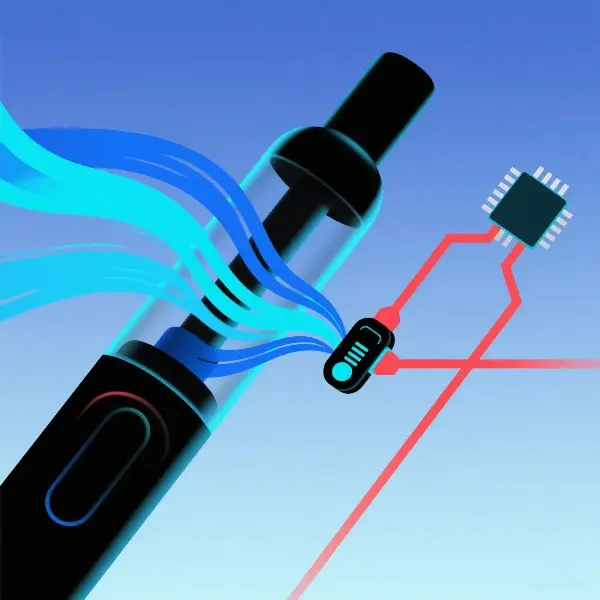
- Negative Pressure Sensing: The airflow through the drip tip’s inner diameter (510/810 size) creates a pressure difference. The built-in MEMS (Micro-Electro-Mechanical System) sensor can detect tiny changes in pressure, with a precision of ±0.05kPa. This activates the control chip in vapes, which responds to changes in pressure.
- Inhalation Mode Recognition: If you inhale at a high resistance (more than 500 Pa) through your mouth to your lungs (MTL), the device will output gently (10–20 W). If you inhale at a low resistance (less than 200 Pa) through your lungs directly (DTL), the device will output strongly (50–80 W). This means you can easily adjust the power to suit your preferred vaping style.
- Anti-Misuse Protection: The device will switch off automatically after more than 8 seconds of continuous inhalation. This activates a special safety feature that prevents the coil from overheating and burning out. This not only prevents coil dry burns but also reduces the chance of the device failing by over 70% among new users.
Heating Activation: Precise Power Regulation via PWM Technology
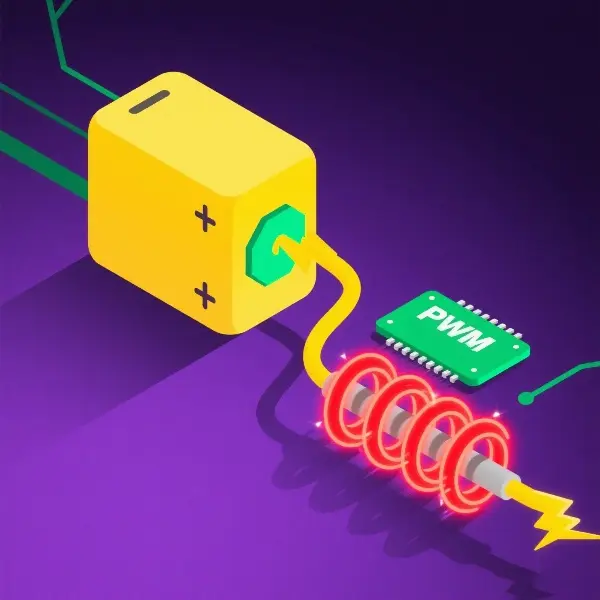
- Battery Energy Management: A lithium battery (3.7V/2500mAh) sends power through gold-plated electrodes. The mod chip uses pulse width modulation (PWM) at 100 kHz to switch the current on and off quickly, adjusting the conduction time ratio to control the power output to within ±0.5 W through vape PWM technology for precise heating.
- Pre-Heat Optimization Algorithm: When a new coil is detected, the chip uses 1.2 times the normal power to quickly increase the temperature of the heating wire to the target (error range: ±2 °C). This solves the problem of the first puff temperature being inconsistent by making sure the first puff is always the same temperature.
- Voltage Stability Mechanism: When the battery gets low, the system automatically increases the conduction ratio (from 70% to 85%) to make sure that the output stays steady. This is called low-battery power stability technology.
Atomization Process: The Micro-Engineering of Wicking and Vaporization

- E-Liquid Delivery System: The e-liquid (made up of 60% vegetable glycerol and 40% propylene glycol) in the tank soaks into the ceramic fibre wick of the coil through tiny holes, and it’s fully soaked in just 3 seconds (which is faster than the usual 5 seconds). This helps to stop the risk of dry burning when vaping, by making the wicking system better.
- Efficient Vaporization with Mesh Coils: Stainless steel mesh coil technology vaporises 0.15ml of e-liquid every second at 180°C, producing 3 times more micron-level vapor particles (2–5μm) than traditional coils. This makes the vapor volume and flavour purity better through large vapor production and flavour purity.
- Airway Temperature Regulation: Vapor is made cold enough to be inhaled easily (around 42℃) through a 45mm spiral channel, which reduces the amount of condensate in the air by over 90% thanks to special technology.
Dynamic Adjustment: Real-Time Temperature Management via PID Algorithm
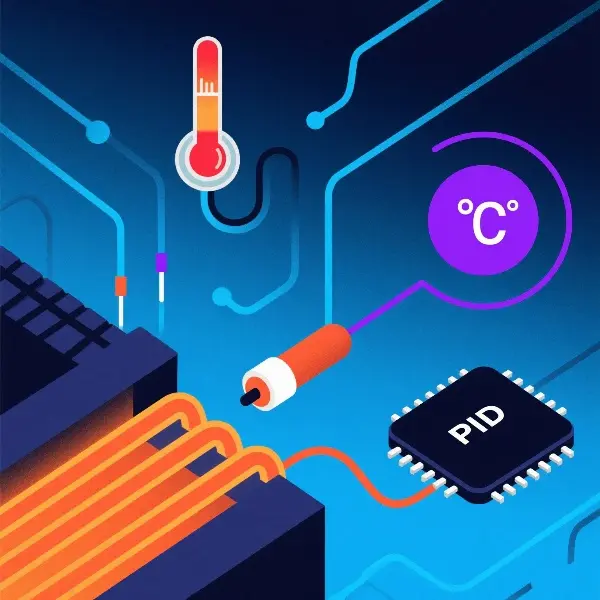
- Resistance Monitoring: The mod can read coil resistance 100 times a second (±0.005Ω). If resistance increases because of poor wicking (e.g., 0.5Ω→0.7Ω), the PID (proportional-integral-derivative) algorithm reduces output power by 15% to keep the target temperature (220℃±5℃), and makes the coil last 20% longer, thanks to the PID algorithm for coil lifespan extension.
- Multi-Material Compatibility: The system supports materials for temperature control, such as nickel (Ni200), titanium (Ti), and stainless steel (SS316). It allows users to set temperature limits (100–300°C) based on coil material, making it suitable for both mouth-to-lung and direct-to-lung high-temperature needs.
- Usage Habit Learning: The high-end mods can store data for the five most commonly used coils. They do this through the coil data memory function. This function automatically matches the optimal power curves for each coil. This makes sure that each coil gets a vaping experience that is just right for them.
Safety Protection: A 24/7 Safety Net with Seven-Layer Protection
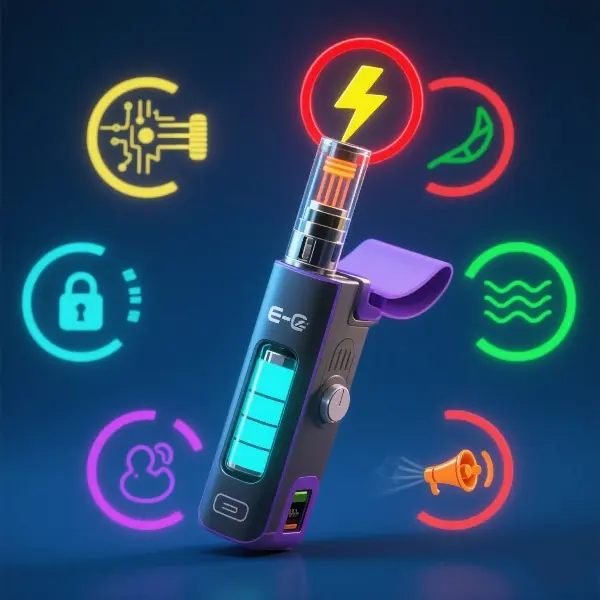
The vape’s safety mechanisms act like seven invisible guardians, ensuring safety in all situations:
- Overheat Protection: If the coil temperature goes above 300°C or the battery temperature goes above 60°C, two NTC sensors check each other and cut power for 15 milliseconds. This is done with a vibration alert, which prevents damage to components or hazards from high heat through overheat protection.
- Short Circuit Protection: If the circuit resistance drops below 0.1Ω or the current exceeds 15A, the fuse and software lock are activated within 8ms. This stops the battery from catching fire if there is a short circuit.
- Low Voltage Protection: If you switch it off within 20 milliseconds and enable pulse wake-up detection when the battery voltage drops below 3.0 volts, it will avoid irreversible damage from deep discharge through low-voltage protection.
- Overcharge Protection: If the voltage of the battery is more than 4.25V while it’s being charged, the dual cut-off mechanisms (charger and mod) will activate within 1ms. This stops the battery from swelling or exploding because of overcharging.
- Child Lock: Pressing the fire button five times in five seconds will trigger lock mode. To unlock, you need to press and hold the fire button and the adjustment button. This prevents children or pets from accidentally activating the lock (e.g., WASPE 25000 25K Puffs Einweg Vape).
- Tilt Leakage Prevention: The tank has a built-in gravity sensor. This means that if you tilt the tank more than 60° for two seconds, the liquid outlet will close within 100 milliseconds. This reduces any leakage when you are carrying the tank.
- Condensate Alert: When the air is too damp (over 85% RH), the device will vibrate and the power will be reduced by 10% within 50 milliseconds. This reminds users to clean the drip tip and airway to avoid coughing or damage to the coil caused by condensation.
Collaborative Value: From Component Stacking to Experience Upgrade
Vapes are competitive because they combine battery power, chip intelligence, atomisation efficiency, and safety protection into one working system. Every time you inhale, the hardware and software work together perfectly. For users, this smooth collaboration delivers three main benefits:
- Vapes have seven layers of safety protection. This reduces the risk of short circuits and overheating by over 98%.
- Stable Experience: PID temperature control keeps the vapor temperature and concentration errors below 3%.
- Personalized Adaptation: You can customise it however you like, from the inhalation style to the coil material and other vaping settings, so it’s perfect for both new users and experienced vapers.
Understanding these ways of working together helps users choose devices better through a vape device selection guide and also makes the most of performance through proper use (e.g., regular wick cleaning, avoiding over-discharge). The best thing about vapes is how they make it easy to inhale.
Structural Differences Between Vape Types: Design Logic of Disposable, Pod System, and Mechanical Mods
Einweg-Vapes: Plug-and-Play Minimalist Vapor Solutions

Disposable vapes are the most popular type of vape in the vape world because they are easy to use and can be thrown away after just one use. They are shaped like an electronic vapor capsule, which means that the main parts are put into a small body that is the size of your palm. This means that you do not need to look after them.
Core Structure: Ultra-Minimalist Integrated Design
- Micro Energy Cell (Battery): The battery is a 280–400mAh lithium-ion and cannot be replaced. It is a compact power source that can support 300–600 puffs (how long the power lasts depends on how much you smoke). The battery management system (BMS) protects against short circuits, but once the battery is drained, it cannot be recharged. This is because it is designed to be used only once.
- Closed Atomization Module (Atomizer + E-Liquid Tank): A pre-filled 2–4ml e-liquid pod with a closed-loop atomizer design—heating wire (usually traditional coils) and wick pre-assembled, allowing e-liquid to go through to the heating element via capillary holes for instant vaporization on inhalation. This factory-calibrated module means you don’t need to replace or refill the coil, which is great for beginners. However, you can’t customise the taste by adjusting the vapor volume or temperature.
- Smart Sensing System (Airflow Sensor): Built-in micro-pressure sensors activate heating elements within 0.1 seconds via suction-activated technology, mimicking traditional cigarette use with draw-triggered operation—no fire button needed, achieving seamless interaction.
- Lightweight Housing: It is made from food-grade ABS plastic or zinc alloy die-casting, and weighs 15–30g, making it light and easy to hold. Surface painting offers rich colours, but the design doesn’t allow for parts to be taken out, so the insides are fully sealed off. This makes the product non-repairable and disposable when it breaks.
Double-Edged Sword of Structural Differences
- Convenience Advantages: You don’t have to worry about charging, refilling, or coil changing. These vape devices are ready to use straight away, so they’re perfect for outdoor and social situations. They make traditional vapes easier to maintain. Standardised performance (fixed power, pre-tuned e-liquid) helps new users adapt quickly, reducing the risk of burnt coils or leaks from mistakes.
- Environmental Concerns: The fact that the battery and atomizer modules cannot be taken apart makes recycling more difficult. This is causing millions of disposable vape batteries to be thrown away around the world, which is creating problems with pollution and plastic accumulation. Choose brands that can be recycled and that have separate ways to dispose of the batteries. Or switch to pod system vapes to create less waste.
Usage Scenarios and Selection Tips
They are perfect for when you want to switch to vaping or as a backup if you don’t have any other vapes. Their simple design means they are easy to use. If you’re going to use it for a long time, think about using refillable pods. This is a good choice for the environment because it’s cheap and you can refill the pods.
Pod System Vapes: Modular Convenience for Modern Lifestyles
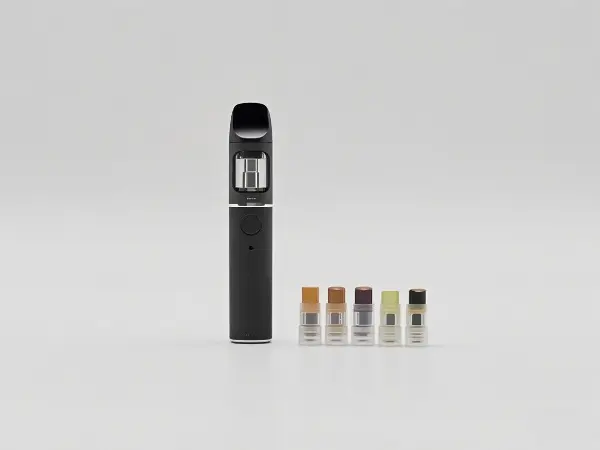
Pod system vapes are becoming a popular choice. They have a main unit and pre-filled e-liquid pods. This makes them easy to use. The main unit has the battery and controls, while pods hold the e-liquid and atomisation cores. You can replace the pods in three seconds using magnetic or snap connections. You don’t need to refill or maintain the pods, which is great for people who have busy lives.
Main Unit: Core of Power and Intelligence
- Long-Lasting Battery: It has a built-in rechargeable battery (500–1000mAh) with fast charging and overcharge protection, so it can be used all day.
- Smart Control: Chips automatically adjust the power to match the resistance of the pods (8-15Ω), so you don’t get burnt coils or weak performance.
- Ergonomic Design: This pebble-shaped device is comfortable to hold in one hand. It has an anti-slip coating and a hidden LED that shows the battery status.
Pre-Filled Pods: Integrated Flavor and Atomization
- Plug-and-Play: The container can hold between 1 and 2 millilitres. It is made of food-grade material and has a clear window. It will not leak if you turn it upside down.
- Atomization Core: The coils are already installed (ceramic for flavour, cotton for richness), and the factory has pre-wetted them to make sure they work well as soon as you take them out of the box.
- Detail Optimization: The mouthpiece is designed to make it easier to inhale vapour, and the airflow at the bottom can be adjusted to suit the user’s preference.
Buying Guide: How to Choose a Gold Standard Pod System
- Interface Compatibility: Choose 510 pod compatibility so you can use third-party pods without being tied to one brand.
- Leak-Proof Design: Make sure you put the double O-ring and the drainage structures first. Then test it to see if there is any leakage when it is upside down.
- Suction Resistance Test: MTL users choose fixed narrow-airflow pods; DTL users opt for adjustable wide-airflow models.
Core Advantages and Scenarios
Pod systems are popular because they are convenient, and you can choose from a wide variety of flavours. This makes them appealing to both new users and experienced users. The product is compatible with all 510-threaded vape cartridges and has double O-ring sealing for easy cleaning.
Mechanical Mods: Chip-Free Pure Vapor Fundamentalism for Hardcore Users
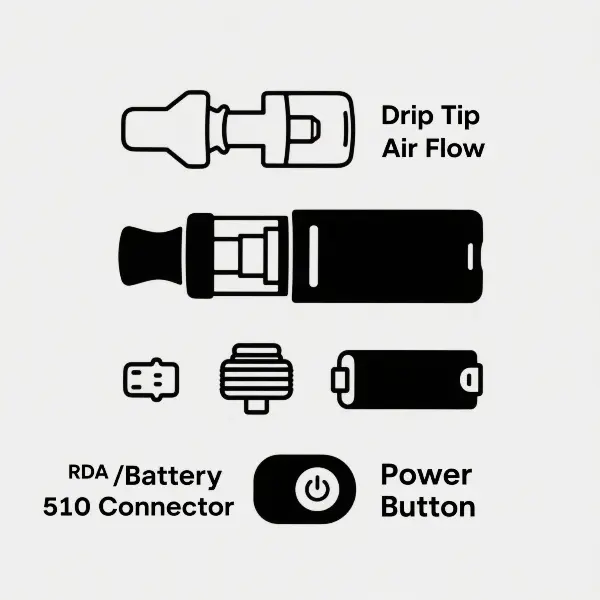
Mechanical mods, with their simple design, are the best choice for experienced users looking for an electrical rush. They don’t use control chips. Instead, they get power from the battery straight to the atomizer through conductivity. These devices are similar to mechanical watches in the vape world.
Three Core Components: Back to Electrical Basics
- Metal Battery Housing: It is made of stainless steel or aluminium and is compatible with high-drain batteries, such as 18650, 20700, and 21700 batteries. The gold-plated interior helps to reduce resistance, making sure that the current is sent through completely via the spring/copper posts that touch the battery terminals.
- Fire Button: A side/bottom mechanical fire button closes the circuit with conductive plates on press, 0.01-second activation without electronic delay. The best models use gold-plated floating contacts to stop them from oxidising, and they can be used more than 100,000 times.
- 510 Thread Connector: This is a top universal 510 thread. It works with almost all atomisers. The current is conducted via phosphor bronze electrodes. If you adjust the electrode screws by hand, you can be sure there’s good contact and you won’t get any sparks from poor connections.
Working Principle: The Naked Journey of Current
Pressing the button connects the battery positive to the trigger to the atomizer to negative, driving coils with a raw voltage of 3.7V to 4.2V. There is no way to control the power or the temperature. The vapour is produced in a way that depends on the coil’s resistance and the battery’s charge. For example, if the coil has 0.2Ω of resistance and the battery has 4.2V, then 88W of power is produced, which makes for really intense vapour production. This is a raw current experience for people who like to make clouds.
Safe Operation: Rules of Experiential Survival
- Battery Rigor: To avoid overheating and fires, use batteries that can provide a minimum of 20A (for example, Sony VTC6). It is very important to keep batteries that use a lot of power safe.
- Ohm’s Law Mandatory: To keep the current within the battery’s limits and avoid damage from voltage drop, calculate the coil resistance manually (R>0.1Ω).
- Maintenance First: Make sure you clean the electrode contacts after you use them to stop them from oxidising and increasing resistance. Also, check the battery spring elasticity regularly to make sure it doesn’t get loose and cause a short.
Why Choose Mechanical Mods?
This is a symbol of vapor purism, meaning it has no chip limits or temperature protection, and works by directly connecting the battery coil. It’s perfect for anyone who knows a lot about batteries and enjoys doing their coil building and tuning wire specifications (like Clapton and twisted coils) to get the best control over the vapor. Remember: it’s a power tool without safety guards—you must be careful.
Portable Vape Pod Systems: Palm-Sized Lightweight Vapor Companions
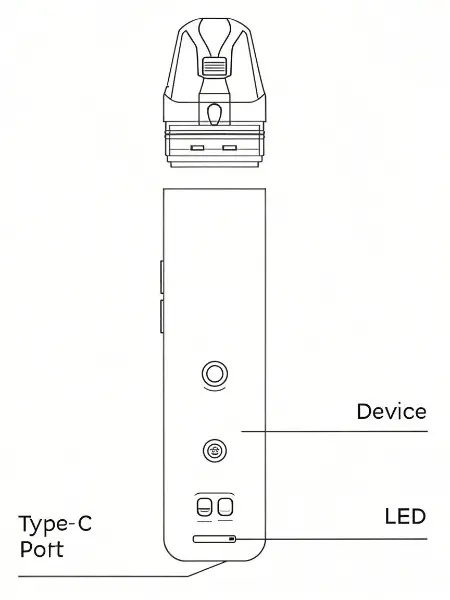
Portable vape pod systems are becoming popular as a smoking substitute. They are small and fit in your pocket. The design is simple, with all the important parts fitted into a small, palm-sized case. This makes them easy to use and still works well.
Core Structure: Modular Simplified Design
- Closed-System Pods: The pods are pre-filled with 1–2 ml of liquid and have three functions:
- Storage & Atomization: The plastic is food-grade PCTG, which is resistant to nicotine salt corrosion. It has pre-installed coils (0.8Ω–1.5Ω) and is pre-wetted at the factory for stable vapour on insertion.
- Comfort Mouthpiece: The design is curved to fit your nose comfortably and stop you from breathing in condensation. Some models have built-in valves to stop water from leaking if you invert the mask.
- Electrode Connection: The bottom of the pod is gold-plated and has magnetic and snap docking for quick replacement.
- Integrated Battery Unit: The device has a zinc alloy/ABS body (no more than 20 mm thick) with a 200–500 mAh battery. It supports Type-C fast charging (1-hour full charge). It is easy to use and will last all day (300–600 puffs).
Trade-offs Between Portability and Performance
- Battery Limitations: You will need to charge it every day because it has a micro-battery. It is suitable for people who don’t smoke a lot (less than 200 cigarettes a day).
- Power Output: The 6–15W output reduces the amount of vapour by 40% compared to traditional mods, but the efficient delivery of nicotine salt is similar to the sensation of smoking a cigarette.
- Scenario Fit: These are perfect for using on the go, like when you’re commuting or in meetings. They’re cheap, quiet, and small enough to be discreet. They’re a great alternative for people who smoke in public places.
Why Choose Pod Systems?
The best way to stop smoking is to use a system that does not need to be refilled, changed, or pressed. It’s perfect for people who are just starting out and want to get into good habits, or as a backup for high-power devices. They make big sacrifices in battery life and power for easy-to-use convenience. They are the disposable cameras of the vapor world – simple, direct, and focused on the most important things.
Vape Material Safety and Health Risks: Analyzing Potential Controversies in Metal Components and Atomizer Coils
Nickel Allergy Risks in Vape Metal Components
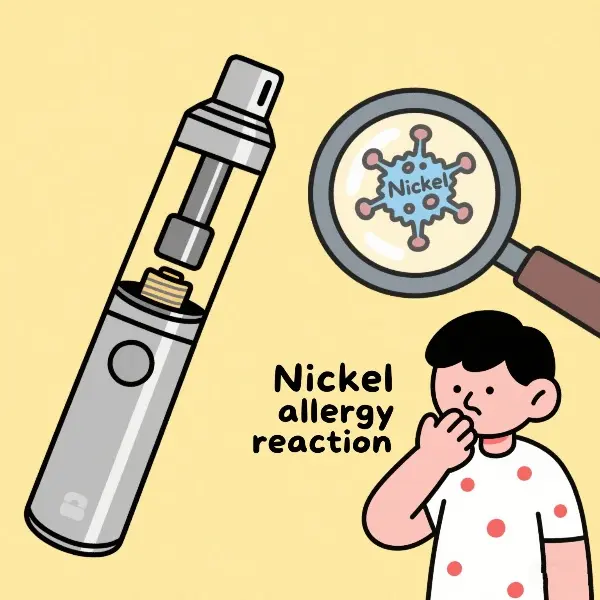
Metal parts in vapes (e.g., atomizer coils, housing) may contain nickel and other elements, which can be harmful to people who are sensitive to metals. This analysis looks at how metal allergies can be caused by vapes, what the symptoms are, what the scientific evidence is, and what protective measures users can take to avoid the risks.
Invisible Pathways of Nickel Exposure
Nickel in vapes mainly comes from two parts:
- Atomizer Coils: Traditional coils (e.g., nichrome alloy) may release nickel ions at high temperatures, especially when surface coatings wear or under high power (>80W), increasing the risk of leaching by 30%.
- Metal Housing and Electrodes: Some materials, such as stainless steel and aluminium alloys, can cause skin irritation if they come into contact with sweat for a long time.
Typical Symptoms of Nickel Allergy
Approximately 15% of the world’s population may have a nickel allergy:
- Contact Dermatitis: A red rash that itches or burns on the hand (the back of the hand and fingertips) or lips near the mouthpiece. This can get worse if you keep using it, and might lead to blisters or peeling skin.
- Chronic Allergic Reactions: If you are exposed to it for a long time, it can make your skin thicker, change the colour of your skin, or cause problems with your whole body (for example, breathing problems). But these things are rare.
Scientific Research and Clinical Evidence
- Laboratory Tests: Some low-cost vape coils exceed EU REACH limits (0.1μg/cm²/h) for nickel leaching, particularly when exposed to acidic e-liquids (e.g., fruit flavors), which increase leaching by 50%.
- Clinical Reports: A 2023 DermNet NZ study documented 3 cases of nickel allergy-induced hand eczema from vape metal components.
Five-Step Protection Strategy
- Source Avoidance: Choose Low-Nickel Certified Devices
- Choose coils that don’t contain nickel (e.g., pure titanium or 316L stainless steel) and avoid Ni80 nichrome alloys.
- I would prefer the housing to be made of plastic, resin, or a titanium alloy, so that there is as little metal contact as possible.
- Physical Isolation: Use Protective Covers
- Cover metal parts with silicone or resin to stop them from touching the skin.
- Change the mouthpieces for food-grade plastic to stop lips from touching metal.
- Usage Habits: Reduce Prolonged Contact
- Don’t keep hold of the item for too long on your own. Also, make sure you clean the contact areas regularly with alcohol swabs.
- Use contactless charging (e.g., magnetic charging) to reduce the amount of metal that comes into contact with the plug and socket.
- Component Screening: Identify Hidden Nickel Sources
- Choose gold- or silver-plated contacts over nickel alloy for pod electrodes.
- Avoid e-liquids with a pH level of less than 4, as these can cause metal to leach (i.e., to come out of the liquid and into the air).
- Health Monitoring: Establish Allergy Alerts
- Keep track of how your skin is responding to the new devices for three days. Stop using them if your skin is red or swollen for more than 24 hours.
- Take the parts of your device with you when you go to the doctor so that they can check for allergens.
Industry Standards and Compliance
Key certifications for safe choices:
- EU TPD: Limits the amount of nickel that can be released from coils (no more than 0.1 μg/cm²/h) and housing (no more than 0.5 μg/cm²/week).
- US ASTM F2999: A Set of rules that says how much nickel a person can be exposed to through contact with electronic devices(Mainly for adult jewelry, but some provisions “such as nickel exposure testing” can be extended to electronic devices that come into contact with the skin “such as vapes”).
While nickel allergies only affect certain groups, making vape materials safer is good for all users. If you know what’s in the e-liquids, how to avoid risks, and what to do if you have a problem, you can vape safely.
High-Temperature Chemical Reactions in Vapes: Formaldehyde Risks and the Role of Temperature Control
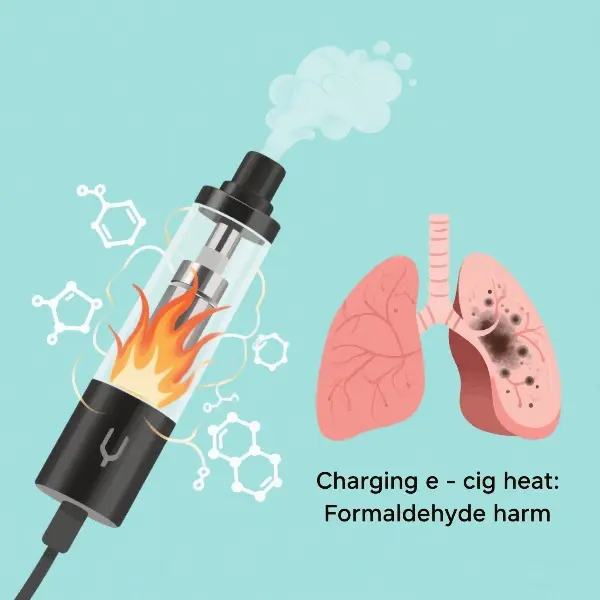
High temperatures in vapes can break down the ingredients in e-liquid, producing harmful aldehydes like formaldehyde. The higher the temperature, the more aldehydes are produced. Studies show that the levels of formaldehyde can be more than 1.5 times higher than those of traditional cigarettes when the voltage is more than 5.0V, especially when people smoke with dry puffs.
Temperature Control: The Core Defense Against Risks
- Voltage-Aldehyde Inverse Relationship: The lower the voltage (3.0V), the better it is at reducing formaldehyde and acetaldehyde by 60% compared to 5.0V. This is because a gentler atomisation (180–220℃) prevents excessive e-liquid cracking.
- Advantages of TC Devices: Mods with PID temperature control technology keep the temperature steady at between ±5℃, stopping abnormal heat and reducing harmful substances.
Practical Risk Mitigation in Use
Most high-formaldehyde lab data comes from extreme tests (e.g., dry burning). There are ways for users to reduce risks:
- Prevent Dry Puffs: Keep the e-liquid containers filled and stop using them when they are hard to suck from or taste strange.
- Choose TC Devices: Put the most importance on mods that can control the temperature. These should be compatible with nickel, titanium, and stainless steel coils to make sure the temperature is right for the best vape.
- Regular Maintenance: Use cotton swabs to clean the atomizer coils every two weeks. This will remove any carbon deposits and stop the coils from overheating in one place.
Balancing Experience and Safety
It uses low voltage (3.3–4.2V) with temperature control, which balances flavour and safety by keeping aldehyde levels within safe ranges. Heating it moderately keeps the taste and health of the food.
Vape Industry Certifications: The Compliance Code of CE and RoHS
CE and RoHS certifications are important for checking how safe and eco-friendly vapes are. They have different but connected roles.
CE Certification: The Safety Pass for Market Access
- Core Scope: The CE marking for e-cigarettes makes sure they meet EU rules about low voltage, electromagnetic compatibility, and fire safety. This includes making sure they are safe to use electricity, are safe from radiation, and do not catch fire.
- Manufacturer Responsibilities: Brands must pass third-party testing (TÜV, SGS), submit technical files (TCF), and sign a DoC declaration to confirm that they meet basic health, safety, and environmental requirements.
- Common Misconception: CE is a way of showing that a product meets the minimum safety standards set by the EU. It doesn’t certify the quality of the product, but it does guarantee that it is safe.
RoHS Certification: Defending Against Hazardous Substances
- Regulatory Goals: The RoHS directive restricts a number of chemicals in vapes. These are lead, mercury, cadmium, hexavalent chromium, PBB, PBDE (and later expanded to 4 phthalates). The aim is to protect health and the environment, with concentrations below certain thresholds (e.g., cadmium ≤0.01%).
- Relation to CE: If you want to use the CE logo on your product, it must be RoHS compliant. If it isn’t, it won’t be allowed to bear the CE marking. This is especially important for products with metal parts, like coils and batteries.
Three Dimensions for Comprehensive Quality Assessment
- Certification Portfolio: Focus on products that have CE, RoHS, and TPD certifications, which are common in UK/German market models.
- Manufacturing Quality Management: ISO 9001 certification shows that there are standard processes in place for coil soldering, battery ageing tests, and so on.
- Real User Feedback: Look at information about long-term leakage rate, battery degradation, and coil lifespan. This is important information that is not covered by certifications.
Purchase Tips: Beyond Certifications
- Beware of Fake CE Products: You can check CE validity via the EU database using the product number, as some low-cost devices misuse the logo without testing.
- Check Certification Currency: Choose models certified in the last year to make sure you have the latest technology and processes.
CE and RoHS certifications are important for meeting legal standards, but to really know if a product is high quality, you also need to look at how well the manufacturer is trusted, what people are saying about it, and how well it actually works in the real world. Certifications are important, but you should also consider data and feedback when it comes to the final evaluation. Safety is the most important thing, but comfort and durability are also important for the experience.
Vape Buyer’s Guide for Users: How Newbies and Veterans Match Devices to Needs
Vape Selection Guide: New Users vs. Experienced Vapers
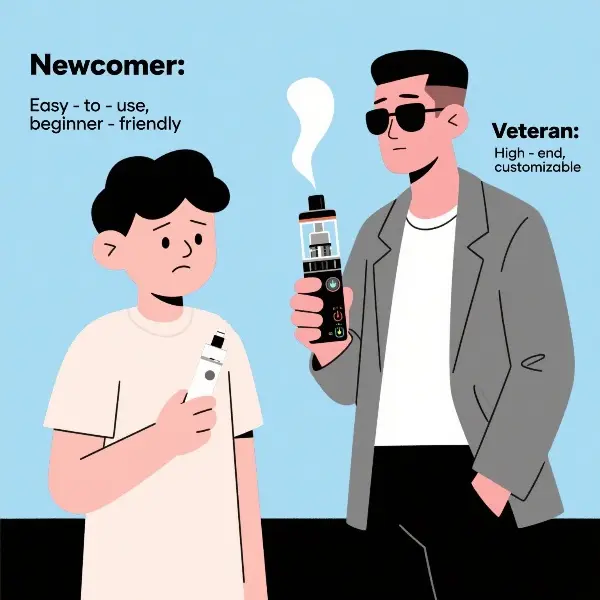
When choosing a vape device, it’s important to think about how experienced you are, what you like to taste, how thick you like your vapor, and how easy it is to carry around. Here is some advice for different users:
- New Users (Suitable for “Beginner Vape Recommendations”)
- Profile: First-time users prefer a simple experience that is similar to smoking a cigarette.
- Recommended Devices:
- Pod Systems (Pod Vapes): These compact devices are ready to use straight out of the box, and they provide a sensation similar to smoking a real cigarette. This makes them perfect for “portable vape recommendations.”
- Advantages: It is easy to carry, doesn’t require any training, and tastes just like the real thing.
- Considerations: The battery is smaller (it needs to be charged more often), and the vapour volume is limited (so it’s not suitable for people who like to make clouds).
- Experienced Users (Suitable for “Advanced Vape Device Selection”)
- Profile: If you like customisation, high vapor volume, or deep flavour, this is the one for you.
- Recommended Devices:
- Adjustable Power Box Mods: You can use these to inhale directly into your lungs (DTL), and you can adjust the power, temperature, and airflow to suit you.
- Advantages: It makes a lot of vapour and can be customised to suit your tastes.
- Considerations: The larger size is less portable. It requires knowledge of the settings (see “Box Mod usage tips”).
- The Balanced Choice (Suitable for “Mid-Power Pod Mod Recommendations”)
- For users wanting portability + performance: Pod Mods combine the lightness of a Pod System with the adjustability of a Mod, making them perfect for devices that need to balance flavour and vapour volume.
Key Takeaway: New users like Pod Systems because they are easy to use. Veterans like Box Mods because they can be adjusted to suit them. Those who like to find a balance go for Pod Mods. If you know what type of inhalation you prefer (MTL or DTL), you can make better choices and enjoy the experience more.
Vape Selection by Price Range
The price of a device often reflects how well it works, what it can do, and how good it is. Here is a simple guide to the different price levels:
- Entry-Level ($10–$30)
- Types: Most vapes are disposable or can be refilled.
- Features: It’s simple to use and doesn’t require any complicated adjustments, making it perfect for beginners.
- Performance: Smaller batteries (500–800mAh) have limited battery life and basic vapor volume and flavour.
- Ideal For: New users or people who vape sometimes and want something cheap.
- Mid-Range ($30–$80)
- Types: You can get rechargeable vape kits or basic open-system devices.
- Features: You can make basic adjustments like power (10–30W) and airflow control to get the experience you want.
- Performance: Moderate batteries (1000–2000mAh) make the battery last longer. You can also see big improvements in the amount of vapour and the flavour.
- Ideal For: Experienced users looking for options that are good value for money and offer more features.
- High-End ($80+)
- Types: Premium open-system devices, high-performance box mods, or luxury refillable kits.
- Features: It has smart functions like temperature control, Bluetooth connectivity, screen displays, and high customisation.
- Performance: These batteries are large (2000–3000 mAh+) and long-lasting. They are made of stainless steel or ceramic, which means the vapour is smooth and the flavour is exact.
- Ideal For: Experienced vapers looking for the best possible performance, custom set-ups, and high-quality craftsmanship.
Purchase Tips
- Price-Feature Balance: Entry-level models focus on the basics and portability. Mid-range models balance performance and budget. High-end models offer professional-grade customisation.
- Informed Choices: Decide which one you want based on how often you use it, what flavour you like, and how much you want to spend. Don’t spend more than you can afford or put safety at risk. Make sure you buy from a company that is certified (CE, RoHS) and that will help you if you have any problems after you’ve bought the product.
Find the right device for you, and you’ll be vaping safer and happier.
Vape Maintenance and Troubleshooting Tips: Extend Lifespan + Solve Common Issues Like Leaks and Dry Hits
Maintenance for Longevity
If you look after your vape, it will work better and last longer. Here are some tips for cleaning the battery and atomizer:
Battery Storage Temperature and Maintenance
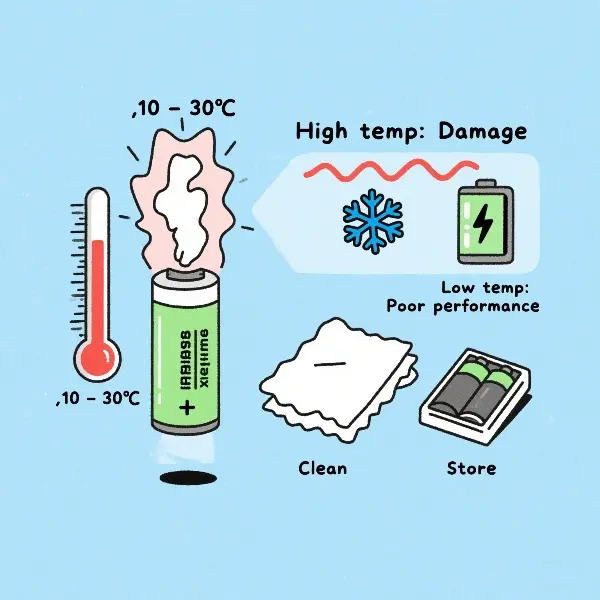
Vape batteries (especially lithium-ion) can be affected by temperature. If you store it properly, it will last longer and be safer:
- Ideal Storage Temperature: The best temperature for the battery is between 20°C and 25°C (68°F and 77°F), as this helps to keep the battery stable and stops it from losing its power quickly.
- Extreme Environments to Avoid:
- High Heat (>45°C/113°F): Don’t leave it in the sun, on a windowsill, or in hot weather, as this can make it overheat, reduce its capacity, or cause a short circuit.
- Low Cold (<0°C/32°F): It slows down the chemicals inside the battery, which can make the battery last for a shorter time. It can also cause permanent damage if the battery is stored for a long time.
- Moist Environments: Moisture can cause rust or short-circuit batteries, so store them in dry places away from liquids.
- Daily Storage Tips:
- When you’re not using your devices or batteries, keep them somewhere cool and dry. Make sure they’re away from anything that could cause a fire, like high-heat appliances.
- If you’re storing your batteries for more than a month, make sure you charge them to between 50 and 70%. Try not to fully charge them or let them run completely empty. And remember to check the levels from time to time.
Atomizer Cleaning Frequency and Methods
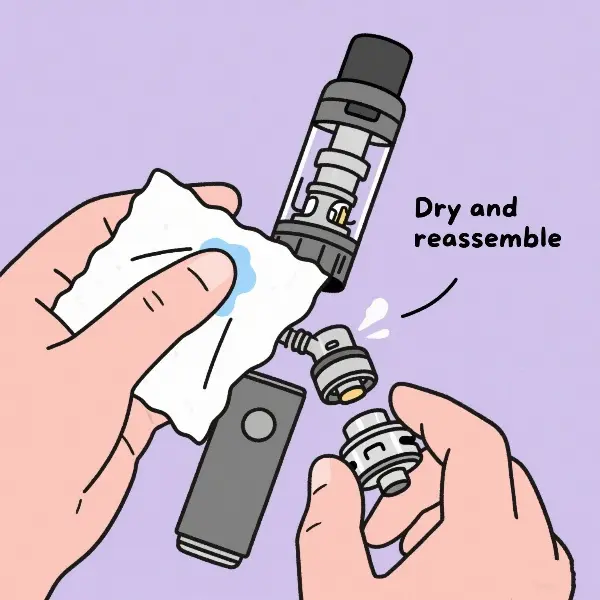
Cleaning the atomizer (including coils, tanks, drip tips, etc.) directly affects the flavour, the volume of vapour, and how long it will last. Change the frequency based on how you use it and the type of e-liquid you use:
- Basic Cleaning Schedule:
- Daily/Every Other Day: Wipe the outside of the drip tip and atomizer with a clean, damp cloth or cotton swab to remove dust, condensation, or e-liquid residue and prevent bad smells.
- Deep Cleaning (Every 2–4 Weeks or When Replacing Coils): If the flavour fades or the vapour decreases, thoroughly clean the atomizer:
- Disassemble Components: Remove the drip tip, coil, and tank (empty remaining e-liquid first).
- Soak and Clean:
- Stubborn Stains: To clean the parts, soak them in warm water or a detergent that is neither alcohol-based nor acidic for half an hour. Avoid using alcohol-based detergents, as these can damage plastic.
- Metal Parts (e.g., atomizer chambers): Wipe them with a cotton swab soaked in isopropyl alcohol (that’s medical alcohol) to get rid of any carbon deposits or sticky residue.
- Scrub and Rinse: Gently brush the nooks and crannies with a soft-bristled brush (e.g., toothbrush), then rinse with water to make sure there’s no soap left.
- Dry and Reassemble: Let the parts dry for 2–3 hours before putting the coil back in and refilling the e-liquid.
- Special Case Handling:
- High-viscosity e-liquids (e.g., sweetened or nicotine salts) need to be cleaned more often (every 1–2 weeks) to stop residue from clogging coils.
- If the coil tastes burnt, replace it straight away and clean the atomiser to remove the carbon residue. This will stop it from affecting future use.
Additional Practical Tips
- Coil Care: To get your new coils ready, just drip e-liquid onto the wick. Then, wait 1–2 minutes before using to avoid burning the coils.
- Device Checks: Check the charging ports regularly for anything in them that shouldn’t be there, like dirt or rust. Also, make sure the atomizer is firmly connected to the mod. This will stop any problems from happening because of poor contact.
- Troubleshooting: If your device won’t start or charge, check the battery level, clean the contacts, or try a new charging cable. If you still have problems, contact customer service.
If you store your vape battery scientifically and clean your atomiser regularly, you can make it work better, enjoy it more and use it for longer. The most important thing is adjusting how often you do maintenance based on your use of the equipment.
Common Issues and Solutions
Leaking and dry hits are common vape problems. Here’s how to address them:
How to Fix a Leaking Vape
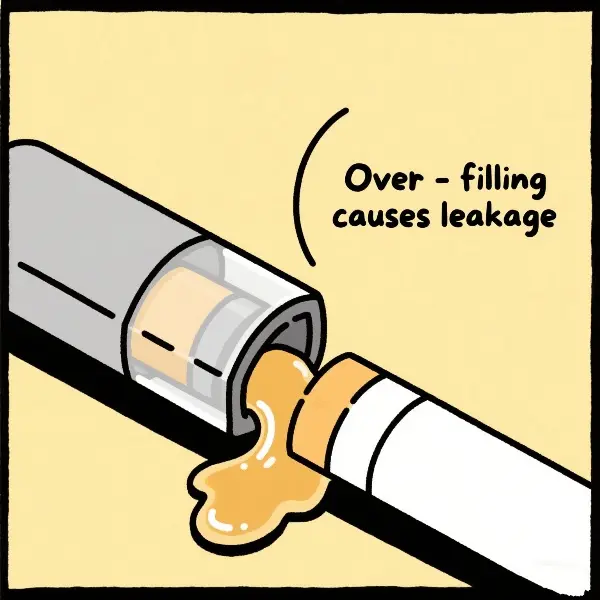
- Possible Causes:
- If the O-rings are worn or misaligned, they won’t seal properly.
- Filling the tank more than it can hold.
- Changes in pressure (like going to high altitudes or flying in planes) can cause e-liquid to seep out.
- A build-up of liquid in the airway is sometimes mistaken for a leak.
- Solutions:
- Check and change O-rings regularly to make sure they are tight.
- Don’t fill the tank more than two-thirds full. This will help stop it from bursting.
- Before you go on a trip to high altitudes, you should empty the tank or seal it so that there is no risk of a leak caused by pressure.
- Clear the liquid from the airway by gently shaking the device.
How to Prevent Dry Hits
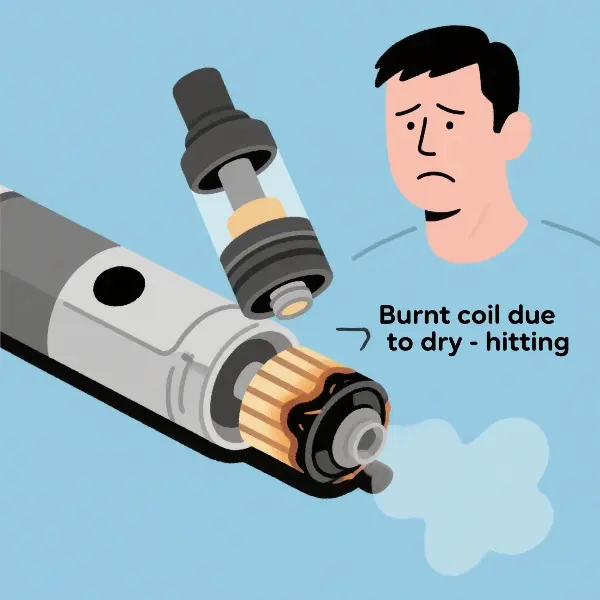
- Possible Causes:
- The cotton is dry, so the e-liquid doesn’t saturate it properly.
- The power settings are too high, which means that the vapor is produced more quickly than it can be absorbed.
- Thick e-liquids (with a high VG ratio) can make it harder for the wicking to work.
- The coils are worn out, and there is a buildup of carbon, which stops them from absorbing liquid.
- Solutions:
- Prepare new coils by soaking them in e-liquid for 15 minutes to ensure the wicks are fully saturated.
- Make sure the power settings match the coil’s recommended wattage range to avoid overheating.
- Use e-liquids with the right amounts of VG and PG to make sure that the wicking is smooth and consistent.
- If the flavour gets worse or your food tastes burnt, you need to replace the coils straight away. This will stop the problem from getting worse.
Targeted maintenance solves leaks and dry hits, making vaping more enjoyable.
The e-cigarette industry is changing in two ways. First, there are more and more strict rules, and second, there is a lot of new technology. Smart technology is a big part of this. In the future, products may be able to learn about your user habits and recommend how much nicotine to use, so that vaping is a more personalised experience for each user.
So, users should check local vape rules and choose products that meet standards like CE and RoHS. Make reusable vape devices a priority to reduce the environmental impact of disposable vapes.
Exploring smart vape devices can make your experience better through features like automatic power adjustment and flavour memory. For example, Bluetooth-enabled vape mods that adapt to your preferences.
Decide how strong the nicotine is based on what you need: products without nicotine or with less nicotine are perfect for people who want to reduce the harm or stop smoking, especially when used with devices that can track how much nicotine you are using to help you manage your habits.
In this time of big changes in the industry, it will be very important to balance compliance (following the rules), sustainability (being kind to the environment), and technological innovation (new technology) if we want to get the most out of vaping.
FAQ
How long do vape batteries last?
How long the battery lasts depends on how much charge it has, how often it is used, and how well it is looked after. Built-in batteries usually support 300–600 puffs per charge (how much power they can handle). A 500mAh battery used for 100 puffs a day may last 2–3 days. Keeping the electrode contacts clean and not over-discharging (charging when the voltage drops below 3.0V) will make it last longer. Lithium-ion batteries can be used 300 to 500 times before they need to be replaced.
How often should I replace the cotton in my atomizer?
Replacement frequency for pre-built coils (with cotton) varies by usage:
- MTL devices (pod vapes): You should check every 7–10 days, or when the food tastes burnt or has lost its flavour.
- DTL devices (high-power mods): The process of carbonisation of the cotton is accelerated by high power every 3–7 days. Key indicators: If it tastes burnt or there’s a lot less vapour, it needs to be replaced straight away. Make new coils prime (ready) by dripping 3–5 drops of e-liquid onto them, then letting them sit for 5 minutes to make them last longer.
Why is my vape producing less vapor?
Common causes:
- Low battery: If the voltage is low, the heating power will be reduced, but the device will recover its full power if the voltage is increased again.
- Clogged/old coil: If there’s a buildup of carbon or e-liquid residue, it can stop the coil from working properly. So, you’ll need to replace the coil.
- Low/thick e-liquid: Refill the tank; high-VG e-liquids pair best with low-resistance coils for faster wicking.
Why does my vape make a hissing noise?
Normal sounds usually come from:
- Vaporization noise: You might hear a “crackling” sound as the e-liquid soaks into the wick and turns into vapor. This is a normal part of the process.
- Condensate buildup: If you hear a “gurgling” sound from liquid in the airway, just shake the device upside down or wipe it with a cotton swab. If you notice any leaks, strange smells, or power problems, check for worn O-rings or if the coils are not installed properly.
If you take care of your vape (e.g., cleaning the atomizer and using the right power settings), it will last longer and work better.
